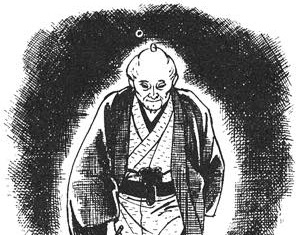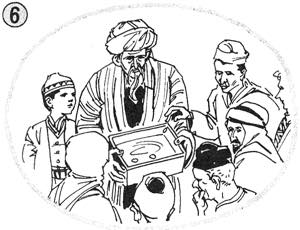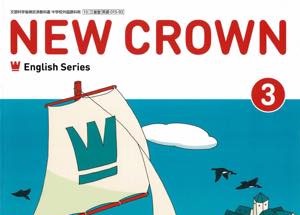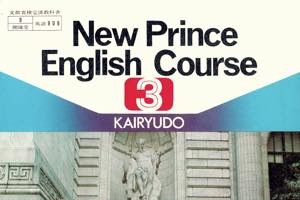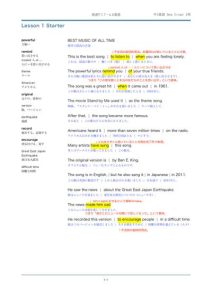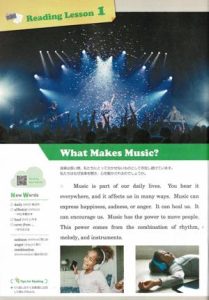これまで昭和・平成の中学英語教科書の素材を紹介してきましたが、最新の教科書にも良い教材が見つかったため、ここで紹介しようと思います。
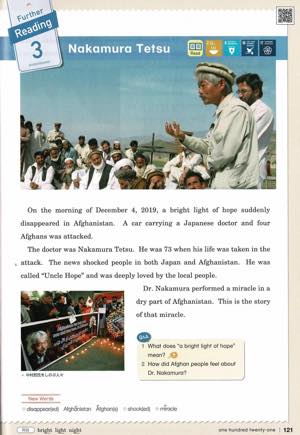
この素材は、令和七年(つまり今年)発行の開隆堂『Sunshine English Course 3』に掲載されているFurther Reading 3「Nakamura Tetsu」というタイトルで、この教科書の最後の章に当たり、読み物という位置付けになっています。
アフガニスタンで活動した医師、中村哲氏の短い紹介文で、よくまとめられており、感動的な話でもあります。中村哲氏も亡くなって5年以上経ち、世間の記憶も薄れ始めているかも知れませんが、こうして若い世代にその偉業を伝えるのは価値のあることで、しかも読み物としても面白いものに仕上がっています。実際に中村氏の話を中学生にしてみましたが興味を持っていました。若い世代のロールモデルになりうるような存在で、こういう題材を選んだ教科書作成者に敬意を表したいと思います。単語については、やや難しいものもありますが、(『ニュークラウン』のように)突飛なものはなく、良い選択だと感じられます。文章も自然で読みやすい良い文章です。
今回も対訳を付けました(対訳は、自然な日本語にするため、かなり意訳しています)。中3の素材としてはやや難しいかも知れませんが、英語中級者の音読の素材としても優れていると思われます。(内容を理解した上で)何度も口に出して読めば、英語読解力を向上させることができるでしょう。
Further Reading 3
Nakamura Tetsu
追加リーディング素材3
中村哲
On the morning of December 4, 2019, a bright light of hope suddenly disappeared in Afghanistan. A car carrying a Japanese doctor and four Afghans was attacked.
The doctor was Nakamura Tetsu. He was 73 when his life was taken in the attack. The news shocked people in both Japan and Afghanistan. He was called "Uncle Hope" and was deeply loved by the local people.
Dr. Nakamura performed a miracle in a dry part of Afghanistan. This is the story of that miracle.
2019年12月4日朝、アフガニスタンで、希望の明るい星が突然消えた。日本人医師と4人のアフガニスタン人を乗せた自動車が攻撃を受けたのだ。
その医師とは中村哲だった。攻撃によって命を奪われたとき、彼は73歳だった。このニュースは、日本とアフガニスタンの両方で人々に衝撃を与えた。彼は「Uncle Hope(希望おじさん)」と呼ばれており、地域の人たちに深く愛されていた。
中村氏は、アフガニスタンの乾燥地帯で奇跡を起こした。これは、その奇跡の物語である。
In the summer of 2000, Afghanistan experienced a historic drought. There was not enough food or water, so people sometimes fought over them. Four million people were suffering from hunger and disease. Many people lost their lives, especially children.
Dr. Nakamura was treating people in a care facility there. "How can I save people without enough food and water?" he asked himself.
He thought the only solution was to draw water from a river. However, the river was much too far. "One canal will be more helpful than a hundred care facilities," he said to himself. Finally, he decided to build a long canal.
Dr. Nakamura didn't know how to build a canal. So he studied hard by reading technical books. He understood it was not easy to draw water from the nearby river because its stream was rapid. "How can I do that?"
2000年の夏、アフガニスタンは歴史的な干ばつを経験した。食べ物も水も十分ではなくなったため、人々はそれを求めて争った。400万人もの人々が飢えと病気で苦しんでいた。多くの人々、特に子どもたちが命を失った。
中村氏は、現地の診療所で住民の診療に当たっていた。「十分な食べ物も水もない状況で、どうすれば人を救うことができるというのだろうか」と彼は自問した。
唯一の解決策は川から水を引くことだ、と彼は考えた。だが、川はあまりにも遠すぎた。「100の診療所よりも1本の用水路の方が役に立つだろう」と彼は心の中で思った。そしてとうとう、彼は長い用水路を作ろうと決心したのだった。
中村氏は、用水路を作る方法を知らなかった。そのため、彼は技術書を読んで懸命に勉強した。(その後)近隣の川の流れが急であることから、水を川から引くことが簡単ではないということがわかった。「どうすれば良いだろうか」
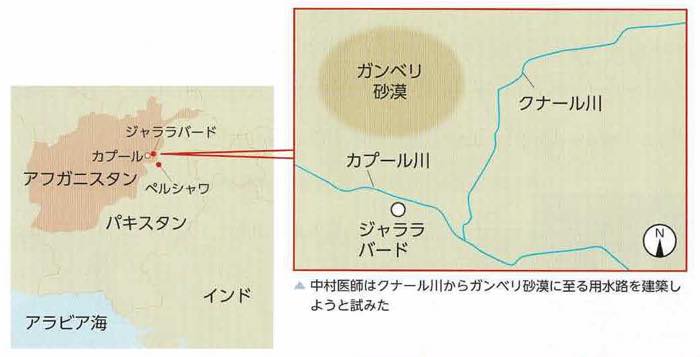
One day, Dr. Nakamura got some ideas when he walked around the rivers of his hometown Fukuoka. He noticed the water in the Chikugo River moved as fast as that in the river in Afghanistan. Thanks to the special construction developed in the Edo period, the river's water is drawn into a canal gently. He decided to do the same construction in Afghanistan.
The construction started in 2003. Dr. Nakamura used another Japanese traditional technique called jakago. It is also the name of huge wire nets filled with lots of rocks. He put 30,000 sets of jakago along the canal to protect it.
Why did he use the traditional technique instead of a new one?
It's because the local people can repair jakago by themselves. Only wire nets and rocks are needed to make it.
He was not alone during the construction. Every day, hundreds of local people worked together with him. They all hoped for a better life.
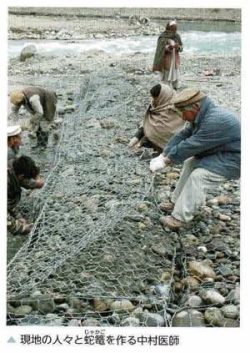
中村氏が、ある日故郷の福岡の川べりを歩いていたとき、ある考えが浮かんだ。筑後川の水が、アフガニスタンの川と同じように流れが速いということに気が付いたのだ。筑後川の水は、江戸時代に作られた特殊な構造物のおかげで、用水路にゆっくりと流れ込んでいる。彼は、アフガニスタンでも同じ構造物を作ろうと決心した。
建設は2003年に始まった。中村氏は、「蛇籠」という名の、別の日本の伝統技術も利用した。「蛇籠」とは、たくさんの岩が入った巨大な金網の名前である。彼は、用水路を保護するために、3万もの蛇籠を用水路沿いに設置した。
彼はなぜ、新しい技術ではなく、伝統的な古い技術を利用したのだろうか。
それは、蛇籠であれば、現地の人々が自分で修理できるためである。作るときも金網と岩以外必要ないのだ。
用水路を建設しているとき、彼は一人ぼっちではなかった。何百人もの現地の人々が、毎日一緒に仕事をしてくれた。彼らも皆、生活の改善を望んでいたのだ。
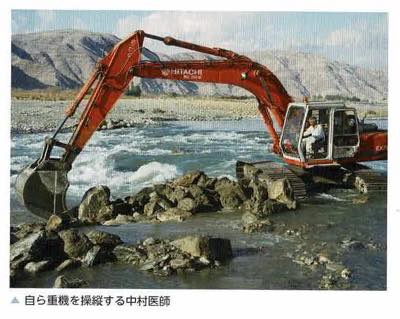
On August 3, 2009, the construction was finally finished. The canal was about 25 kilometers long. Hundreds of people shouted with joy and shed tears.
A few years later, no one could believe their eyes. The dry land became green and beautiful. Now people grow rice, wheat, and vegetables there. According to a report, this canal enabled more than 600,000 people to live there.
Children play with water and keep themselves clean. As a result, the number of children who suffer from disease has decreased.
2009年8月3日、とうとう建設は終わった。用水路は全長約25キロにも及んだ。数百人の人々が、喜びの声を上げ、涙を流した。
数年経ったとき、誰もが自分の目を信じることができなかった。あの乾燥地帯が緑になって美しくなっていたのだ。今、(現地の)人々はそこで米、小麦、野菜を育てている。報告によると、この用水路のおかげで、60万人以上の人々がそこで生活できるようになったという。
子どもたちは、水で遊びながら、自分の身体をきれいに保っている。その結果、病気で苦しむ子ども達の数も減った。
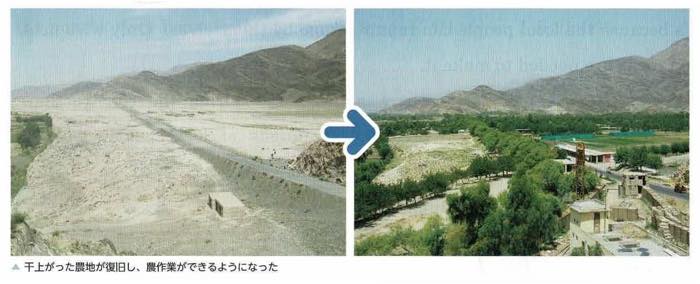
"I guess the men, women, children, animals, insects, and birds were all pleased. Water is the source of life," said Dr. Nakamura. "I felt like I saw a miracle."
Since the local people have enough food and water now, they don't have to fight over them. He showed us a way of achieving peace without weapons. "I didn't aim at peace but rather saving people's lives. However, people got peace as a result of our work," he once said.
In Afghanistan, two picture books were published to remember Dr. Nakamura forever. He is no longer with us, but his hopes and dreams live on.
[575 words]
「男も女も、動物も虫も鳥もみんな喜んだと僕は思う。水は命の源だからね」と中村氏は言った。「奇跡を目にしたような気持ちだよ」
現地の人々は今、十分な食べ物と水を手にしているため、それを求めて争う必要がない。中村氏は私たちに、武器を使わずに平和を実現する方法を示してくれたのだ。「僕は平和を目指していたわけじゃなく、みんなの生活を守ろうとしていただけだよ。でも僕たちの仕事の結果、みんなが平和を手に入れたんだ」と、かつて彼は語った。
アフガニスタンでは、中村氏を永遠に記憶するために、2冊の絵本が出版された。今はもう彼は私たちとともに生きているわけではないが、彼の望みと夢は今も生き続けているのだ。



